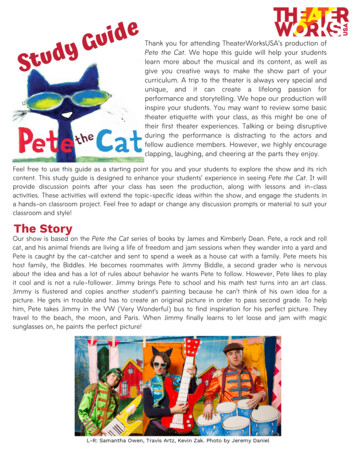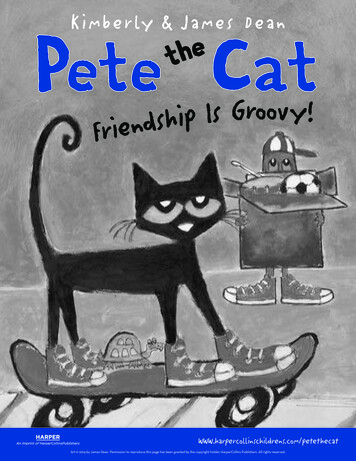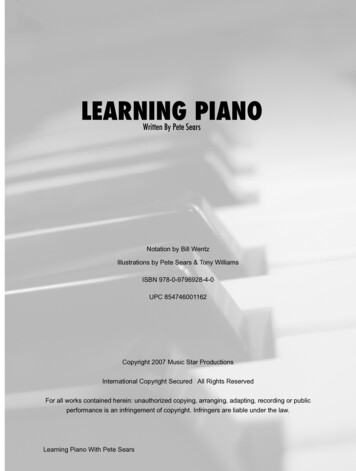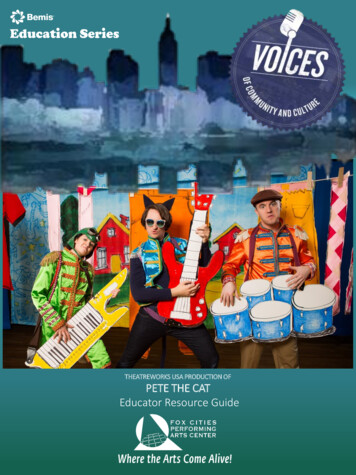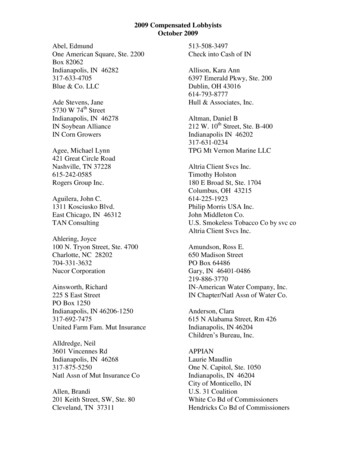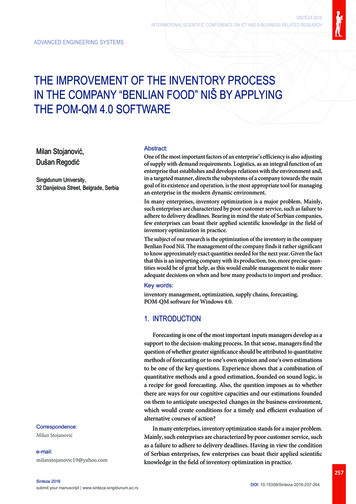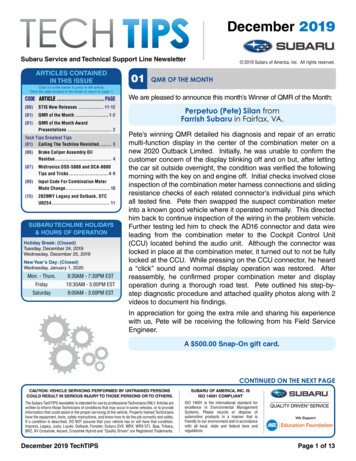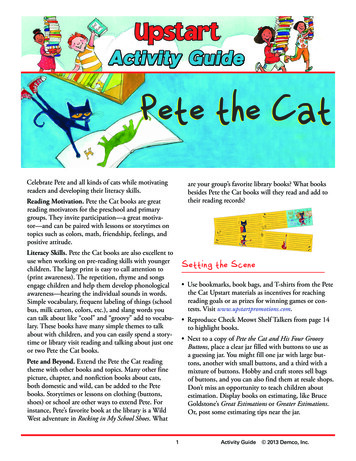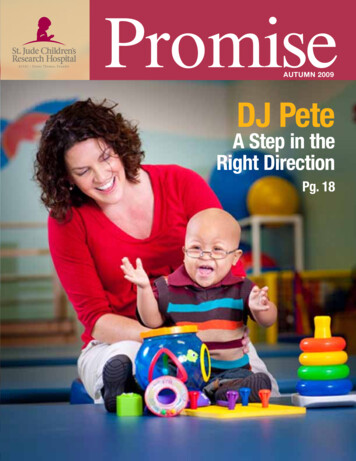
Transcription
Promiseautumn 2009DJ PeteA Step in theRight DirectionPg. 18“DJ” PeteA Step in theRight DirectionPg. 18
Cover story18A Step in the Right DirectionSt. Jude steers tiny DJ Pete onto the right path.Features5The Cross Foundation: Giving with Thanks6Roll Model10Give thanks.12Help Wanted14Putting Family at the Center16Survive and Thrive21In Good HandsFor this couple, gratitude is a way of life.St. Jude helps patient Michael Miller transcend challenges.6Thanks and Giving shares the St. Jude mission.Researchers seek to thwart bacterial meningitis.Families take an active role in decision-making.Without using cranial irradiation, St. Jude achievesthe best-ever ALL survival rates.A peek into the nation’s only ICU devoted solelyto pediatric hematology/oncology patients.Highlights2News and AchievementsPerspective24Sean SwarnerKeep Climbing21Promiseis a quarterly publication of theDepartment of Public RelationsSt. Jude Children’s Research Hospital262 Danny Thomas PlaceMemphis, Tennessee 38105-3678Hospital Director andChief Executive OfficerDr. William E. EvansPrint Production Managerand EditorElizabeth Jane WalkerALSAC Chief Executive OfficerRichard C. Shadyac Jr.Art DirectorJessica W. AndersonSenior Vice President ofPublic RelationsMary Lynn CarverContributing WritersSummer FreemanJanice HillMike O’KellyMary PowersAmanda McGee RobbinsDirector ofPublic RelationsJudith W. BlackProduced by the St. Jude departments ofPublic Relations and Biomedical CommunicationsCarrie L. StrehlauJoyce M. WebbPhotographersPeter BartaSeth DixonAnn-Margaret HedgesJustin Veneman
PromiseA publication of St. Jude Children’s Research Hospital Autumn 200912Editorial Advisory BoardLeah BrooksLeslie DavidsonMark HendricksChristine KirkJon McCullers, MDAva MiddletonJoseph Opferman, PhDSheri Spunt, MDCarrie L. StrehlauPenny TramontozziRegina WatsonSally WiardAmy ScottJohn ZacherSteve Zatechka, PhDOn the cover:DJ Pete and his St. Judeoccupational therapist,Jessica Allen. Photo byPeter Barta.Public Information:1-866-2STJUDE (278-5833),ext. 3306Donations: 1-800-822-6344Visit our Web site at www.stjude.org.St. Jude Children’s Research Hospital,American Lebanese Syrian AssociatedCharities and ALSAC are registeredtrademarks.St. Jude Children’s Research Hospital’s missionis to advance cures, and means of prevention, forpediatric catastrophic diseases through researchand treatment. Consistent with the vision of ourfounder, Danny Thomas, no child is denied treatment based on race, religion or a family’s abilityto pay.St. Jude is an Equal Opportunity Employer. For inquiries about stories in this publication, call (901)595-2125 or e-mail elizabeth.walker@stjude.org.Articles may be reprinted with written permission. 2009.
Serious sillinessSETH DIXONResearch HighlightsPETER BARTAThe Child Life Program strives to minimize the stress andanxiety of children undergoing treatment at St. Jude. Inaddition to providing age-appropriate explanations andpreparations, the staff creates opportunities for play andexpressive activities that promote an outlet for feelings andpeer interaction. One such event is Silly Field Day, in whichpatients, family and St. Jude employees such as Child LifeSpecialist Mirna Brindas face off in friendly combat.Analyzing the AML genomeThe most comprehensive analysis yet of the genome of childhood acute myeloid leukemia (AML) found only a few mistakesin the genetic blueprint, suggesting the cancer arises from just a handful of missteps, according to St. Jude investigators. Theresearch appeared in Proceedings of the National Academy of Sciences in July 2009.“The complement of genetic lesions varies across the different genetic subtypes of AML, but there are very few lesions intotal. That is surprising. Most cancers have lots of alterations,” said James Downing, MD, St. Jude scientific director and thepaper’s senior author.Downing said the findings underscore the need to survey the entire genome of childhood AML and take a more detailed lookat particular AML subtypes.“This rigorous systemic genome-wide study was an important step to direct our future efforts to the most effective strategiesto pinpoint lesions in AML,” added Ina Radtke, PhD, Pathology, the paper’s lead author.Trading needles for magnetsSt. Jude researchers have found that magneticresonance imaging (MRI) is just as accurate for measuringthe body’s iron levels as analyzing a liver biopsy sample.Such measurement is critical to guide treatment of ironoverload.“Iron overload happens because a patient needsrepeated blood transfusions to treat such disorders assickle cell anemia and thalassemia,” said Jane Hankins,MD, of Hematology, the study’s lead author. “This ironaccumulates in critical organs, and it can cause failure ofthese organs.” In the past, monitoring iron levels requiredperiodic biopsies.“Based on results of our study, we feel confident inrelying on MRI from now on, without the need for biopsy,”added Claudia Hillenbrand, PhD, of Radiological Sciences,the study’s senior author. Results of this study appeared inthe journal Blood in May 2009.2 Promise / Autumn 2009Spotlight on survivorsAn extensive study of more than 2,800 long-termsurvivors of childhood central nervous system tumors detailsrisks some survivors face decades after diagnosis. The risksinclude the return of or spread of the original cancer, thediagnosis of a new second cancer and an elevated incidence ofother health problems.The findings were published in the Journal of theNational Cancer Institute in July 2009. The work is part ofthe Childhood Cancer Survivor Study (CCSS), a collaborativeeffort of 30 institutions, for which St. Jude is the centralcoordinating institution.Greg Armstrong, MD, of Epidemiology and CancerControl, said the results highlight the continuing health careneeds of childhood cancer survivors. “This population needshigh-quality, long-term follow-up, preferably by a cancer centersuch as we have here at St. Jude,” said Armstrong, the paper’slead author and a CCSS project director.
A peek into the immune systemSt. Jude investigators recently reported new details of the complex dance that helps maintain immune balance.The work highlights the role that a small protein known as interleukin 35 (IL-35) plays in regulating suppressionwithin the immune system. IL-35 is a novel member of a larger family of signaling molecules, known as cytokines orin the immune system as interleukins, which cells rely on to communicate and to influence how cells behave.Originally identified in the laboratory of Dario Vignali, PhD, Immunology, IL-35 is one of just three cytokinesthat dampen rather than fuel the immune response. The new findings build on the laboratory’s earlier work thatsuggested IL-35 was central to the regulatory function of lymphocytes known as regulatory T cells.The work suggests new treatment and prevention targets for a variety of human diseases, including arthritis,allergies and the inflammatory response following an infection. A report on this research appeared in The Journal ofImmunology in May 2009.Mullighan named Pew ScholarCharles Mullighan, MD, PhD, of St. Jude Pathology hasbeen named a 2009 Pew Scholar in the Biomedical Sciences.Pew Scholars are junior faculty members at medical schoolsand research institutions who show outstanding promise inresearch that is related to the advancement of human health.The Pew Charitable Trusts selected 17 of the country’s mostpromising early-career scientists to receive the award.Mullighan’s research focuses on the use of highresolution, genome-wide approaches to identify genomicaberrations contributing to leukemogenesis and influencingleukemia outcome; the use of in vitro and in vivoexperimental approaches to model genomic abnormalities inleukemogenesis; and the genetics of disease susceptibilityand disease phenotype.Other Pew Scholars at St. Jude have included BrendaSchulman, PhD, of Structural Biology and Genetics/TumorCell Biology; Michael Dyer, PhD, of DevelopmentalNeurobiology; and Joseph Opferman, PhD, of Biochemistry.Mechanism for migrationThe molecular machinery that helps brain cellsmigrate to their correct place in the developing brain hasbeen identified by St. Jude scientists. The finding offersnew insight into the forces that drive brain organizationin developing fetuses and children during their first years.Disruption of this brain-patterning machinery can causeepilepsy and mental retardation, and understanding itsfunction could give new insight into such disorders.Basic understanding of the migration machinery couldhave important clinical implications.“If we more clearly understand how neurons migratein neural development, we will have a better framework toexplain the basis of neuronal migration defects in children,”said David Solecki, PhD, Developmental Neurobiology.“Also, cell migrations may contribute toward the spread ofbrain tumors in children. If we can understand how normalneurons migrate, we might be able to dissect the machineryof the migration of brain tumor cells.”The researchers published their findings in the journalNeuron in July 2009.Autumn 2009 / Promise 3
Research HighlightsTargeting high-risk leukemiasSETH DIXONA research team has pinpointed a new class of gene mutations thatidentify cases of childhood acute lymphoblastic leukemia (ALL) that havea high risk of relapse and death. The finding suggests specific drugs totreat this high-risk leukemia subtype. A report on this study appeared inProceedings of the National Academy of Sciences in May 2009.“We have made such great progress in curing children with ALLthat the main challenge is now the remaining high-risk patients,” said thereport’s co-senior author, James Downing, MD, St. Jude scientific director.Analyzing leukemic cells from patients with high-risk ALL, scientistsdiscovered mutations in about 10 percent of the cases in a family ofprotein kinases called JAK, whose members are also mutated in othertypes of leukemias and related diseases. In some children, JAK mutationsappeared to work in concert with a mutation in the gene IKZF1.In further studies, the researchers plan to identify mutations in kinasegenes and other enzymes that underlie high-risk ALL, as well as explorehow these abnormalities might work together to drive the cancers.Science in the summerThe Summer for Sickle Cell Science Program brings Memphis-area high school studentsinto St. Jude science, research and medical environments for eight weeks eachyear. Funded by the National Institutes of Health, the program gives teens hands-onexperience that could inspire them to pursue science or medical-related careers.Participating in this year’s program were (back row, from left) Julian Earl, BronsonWorthy and Lowell Hays. The students worked in the Hematology department labs of,respectively, Russell Ware, MD, PhD, Hematology chair (seated, at left); Derek Persons,MD, PhD (seated, at right); and John Gray, PhD (standing, at right).4 Promise / Autumn 2009“We have madesuch greatprogress incuring childrenwith ALL that themain challengeis now theremaining highrisk patients.”St. Jude produces cancerkilling immune cellsSt. Jude scientists have createda strategy that dramatically boostsproduction of natural killer (NK)cells for cancer treatment.In a single week, the patentedtechnique generated a 100-foldincrease in NK cells, which area powerful, but rare immunecomponent. Laboratory researchshowed the new cells were moreefficient cancer killers than NK cellsfrom other sources. A report on thiswork appeared in the journal CancerResearch in April 2009.Scientists have been eager toobtain the cancer-fighting cells,which account for just 5 to 10percent of lymphocytes. “Thechallenge was to expand NK cells toget adequate numbers for treatment,”said the paper’s senior author, DarioCampana, MD, PhD, of Oncologyand Pathology. “People have beentrying for decades but have only hadmodest success.”The finding prompted requestsfrom many laboratories worldwidefor the St. Jude cells. The results alsohelped launch a Phase 1 study of theNK cells in St. Jude patients battlingEwing sarcoma, rhabdomyosarcomaand certain leukemias.
The Cross Foundation:Giving with ThanksWith a spirit of gratitude, Rob and ConnieLawrence teach by example.B y J anice H illFor Rob and Connie Lawrence,charitable giving is morethan a philanthropic financialdecision. It’s a way of life, a methodof teaching, and perhaps mostimportantly, an expression of faith.The couple established a privatefoundation approximately 10 yearsago to ensure that their giving couldcontinue and grow throughout theirlives and beyond. Rob explains thatthey named it The Cross FoundationTrust as a symbol of the blessingsthey have been given. “It is a way wecan give thankfully to help others in amission driven by our faith,” he says.While considering which effortsto support two years ago, Roband Connie happened to watch atelevision program about St. JudeChildren’s Research Hospital thataired as part of the Thanks andGiving campaign.“We had seen [National OutreachDirector] Marlo Thomas talk aboutSt. Jude several times before, butsomething about that particularprogram really drew us in,” Connierecalls.“We’ve always been thankfulfor our healthy children, and werealized how giving to St. Jude wouldbe a way to express our gratitude,”Rob adds.Their large donation to St. Judewas made as a gift to their four adultdaughters and families. The couplecreated a package of informationabout the hospital’s mission andlifesaving work, wrapped thepackage and presented it to theirchildren after they had opened theirother Christmas gifts.“It was really a teachingmoment,” Connie says. “They werevery touched.” The couple hadintentionally involved their childrenwith charitable giving in ageappropriate ways throughout theirlives. When their daughters werein high school, each girl receivedmoney to donate to the charity of herchoice. The sole stipulation was thatonly charities that spend a limitedpercentage of donated funds onfundraising should be chosen.Although the Lawrences usuallyselect different charities for theirmost sizable gifts each year, theysay they have repeated their gift toSt. Jude in part because of thehospital’s cutting-edge researchand its commitment to share itsfindings with medical communitiesworldwide.A retired investment managerwith Fidelity, Rob says that settingup a private foundation was right fortheir family. His investment expertisegives him the ability to manage andfocus the foundation’s assets.He recommends that individualsRob and Connie Lawrence involved their childrenin charitable giving throughout their lives.who care about charitable giving butwho may have less financial expertiseconsider setting up donor-advisedfunds at investment companies theytrust.“They will be able to realizeimmediate tax advantages, and whensecurities begin appreciating again,they will be able to direct more tocharities while avoiding capital gainstaxes,” he says.The Lawrences enjoy dividingtheir time between their homes inMassachusetts and South Carolinaand spending time with their threegrandchildren, the oldest of whomis 3 years old. Gradually, Roband Connie intend to teach theirgrandchildren lessons in charitablegiving as they did with their ownchildren.“There is a scripture thatbasically says, ‘To whom much isgiven, much is required,’” Conniesays. “God has blessed us to be ablessing to others. Those are not justwords. It is an obligation.”Foundations that would liketo learn more about St. Jude cancall (800) 830-8119 or e-mailfoundations@stjude.org. lAutumn 2009 / Promise 5
photos by ANN-MARGARET HEDGESWith help from St. Jude, Michael Miller transcends obstacles in his way.B y E lizabeth J ane W alkerAt first glance, Michael Miller’s bedroomresembles the lair of a typical teenager.Rumpled T-shirts and ragged jeans have beenstrewn across furniture and floor. Posters,skateboard decks and castoff guitars float on sky-bluewalls. But closer examination reveals creativity bloomingamid the chaos. Items mounted on the walls are arrangedwith a certain artistic flair. The presence of well-usedmusical instruments, loop pedal and amplifiers attest to thefact that, for Michael, art is serious business.With his subtle, half-smile, quiet voice and sereneeyes, the teen seems an unlikely rocker. But for hourseach evening, he hunches over his guitar. One moment,his fingers fly across the frets with feverish intensity; thenext, they caress the instrument slowly and deliberately.When he’s not practicing, Michael hurtles down sidewalks6 Promise / Autumn 2009and streets on his skateboard, wheels clattering acrossthe seams like a locomotive chugging along a track. Ifhe encounters an obstacle—a ledge, a set of stairs, a flat,open space—he flings his arms out for balance, twirling,leaping and launching himself toward the heavens.“Skating’s a pastime, but music is my passion,”Michael says. During the past two years, these activities,along with a deep faith and extraordinary medical care,have helped him rise above even the most dauntingchallenges.No fearIn July of 2007, Michael was perplexed and annoyedwhen, 10 days after his 16th birthday, he began exhibitingsigns of a serious stomach virus. After a couple of days,Kimberly and David Miller took their son to the doctor,
For the past two years—whetherplaying guitar or skateboarding—St. Jude patient Michael Millerhas refused to allow a stage IVrhabdomyosarcoma diagnosis slowhim down for long. “If we had notgotten to St. Jude when we did,Michael would most likely not be withus today,” says his mom.Autumn 2009 / Promise 7
who discovered a large lump in Michael’s abdomen. “Youneed to take your child to the emergency room,” he toldthe Millers.During the whirlwind that followed, Michaelunderwent an operation to remove what doctors believedto be the primary tumor. Afterward, the local hospital sentthe teen home to recuperate. Minute by minute, hour byhour, Michael’s condition worsened. “I was so scared,”Kimberly says. “He was throwing up all the time. Hecouldn’t stand or walk. I thought it was the end. We didn’tknow whether he would still be with us from one day tothe next. When it would get too bad, we would take himto the ER, where they would give him fluids and send himback home. There was a hopelessness that came over usduring that time.”Kimberly and David found support and strength fromthe most unlikely place—their own son.“At first it was pretty freaky, and I was scared,”Michael admits. “But the night after my surgery I prayedall night long. After that, I knew everything was going tobe all right.” Then he calmed his parents’ fears and helpedthem focus on the task ahead.“God’s going to see me through this; I’m not goingto worry about it,” Michael told them. “Now, where’s thebest place we should go?”Rain on the windshieldFor years, the Millers had heard about St. JudeChildren’s Research Hospital through television andword of mouth. They asked their physician for a referral.By the time they arrived in Memphis, Michael wasextremely sick. “If we had not gotten to St. Jude whenwe did, Michael would most likely not be with us today,”Kimberly says.Physicians quickly determined that Michael had stageIV rhabdomyosarcoma, an aggressive, soft-tissue tumorthat accounts for 7 to 8 percent of childhood cancer cases.Michael’s situation was so precarious that clinicianshad to stabilize his condition before treatment couldbegin. “Michael was very ill,” recalls Sara Federico, MD,Oncology fellow. “On the scans, the tumors looked likerain on a windshield. His abdomen had large masses,which were conglomerations of multiple lymph nodes.His bone marrow was packed with disease, and he hadmultiple lesions in his lungs, and bone. Simply stated,Michael was critically ill on arrival to St. Jude.”According to Wayne Furman, MD, interim directorof the Solid Tumor Division, the cancer actually caused afracture in Michael’s vertebra. “The bone was weakenedso much by the tumor that it compressed,” he explains.8 Promise / Autumn 2009Clinicians enrolled Michael in a protocol for highrisk rhabdomyosarcoma. Furman says the treatment planentails intensive chemotherapy with six drugs for 51weeks, plus radiation and surgery. The study incorporatesa combination of drugs that St. Jude molecularpharmacologists had previously shown to be highlyeffective against the disease.On a rollAlmost immediately, Michael’s condition improved.“He had a remarkable response,” Federico says. “Hisdisease truly just melted away.”The treatment took its toll on the teenager, whobecame super-sensitive to scents. “To me, the radiationsmelled like iodine,” he says. “People would come toRonald McDonald House and serve these amazing meals.But when I’d get near the kitchen, I’d smell the food andI’d turn and run for my room.”As a result, the 5-foot, 9-inch teen’s weight droppedto 110 lbs. Michael credits John Franklin, RN, withhelping him gain weight. “When I was in the hospital,John would come into my room and tell me what lookedgood in the cafeteria that day. Or he would get me takeoutif the nurses were ordering,” Michael says.Like many teens, Michael was tethered to his cellphone, fingers constantly tapping out text messages tofriends. His mom laughs that he could text during medicalprocedures or even in his sleep. “One time, Michael wasFacts about rhabdomyosarcomaRhabdomyosarcoma, a cancer that forms in the softtissues, consists of cells that normally develop intoskeletal muscles. The tumors can arise virtually anywherein the body.Although rhabdomyosarcoma is the most common softtissue cancer in children and adolescents, only 350 casesare diagnosed in the United States each year.More than 70 percent of children with localizedrhabdomyosarcoma experience long-term survival.St. Jude investigators are determined to increase thecurrent survival rates. Several studies are ongoing toidentify the most effective drug combinations to combatthe disease. Clinicians are also interested in reducingthe amount of radiation that is required to ensure a curewhile minimizing the long-term side effects of treatment.
(Left) As part of his protocol, Michael received a combination of drugs that St. Jude molecular pharmacologists had shown to be highlyeffective against rhabdomyosarcoma. “His disease truly just melted away,” says Sara Federico, MD, Oncology fellow.(Center) Michael continued to play his guitar throughout his intensive chemotherapy treatment.(Right) John Franklin, RN, found many ways to encourage Michael during his treatment. During a recent visit to the hospital, Michaeldemonstrated his musical skills for Franklin.actually sedated and they were about to put the needleinto his spine when he tried to reach for his cell phone,”she says.Occasionally, Michael would slip away from thewatchful eye of clinicians, grab his skateboard andpractice ollies, grinds and kickflips. For just a while, hewould be a carefree teenager once again.“He didn’t tell me about that until after he finishedtherapy,” says Federico with a rueful laugh. “It used tomake me nervous when he would go home for visits,because I suspected that he was skateboarding.”In spite of her fears about his activities, Federicolearned to respect the teen for his maturity and positiveattitude. “Michael was a joy to take care of,” she says.“He was well aware of everything he was missing athome. He couldn’t play in his band or hang with hisfriends. But he went through everything with a smile.I never heard him complain about chemo or radiationtherapy. I never heard him complain about the fact that hewas throwing up. He never complained. Ever. He actedlike treatment was a piece of cake, when it wasn’t at all.”Gradually, Michael’s strength improved and thetumors disappeared one by one—even the softball-sizedmass in his abdomen. The lesions in his lungs were thelast to go. Today, his disease is in remission.Back to the grindDavid and Kimberly say they are grateful for thekindness they were shown at St. Jude. “I don’t care whereyou go at that hospital, they make you feel at home andthey treat you like family,” Kimberly says. “We’ve neverreceived a single bill for his treatment. They took all thatworry from us. We already had so many things runningthrough our heads, but St. Jude did everything they couldto make it easier for us. The shuttle would meet us at theairport; we were given meal cards; we were given a placeto stay. Everything was done for us, so that we couldconcentrate on helping Michael get better.“We’ve been really blessed, and we know it,” shecontinues. “We don’t take that for granted.”Hospital staff recently asked Federico why Michael’shands, feet and calves were glowing on a routine PETscan. “The scans can light up in places where you havedisease,” Federico explains, “but they can also light upin places where there’s a lot of activity. You can literallylook on Michael’s PET scans and know that he does a lotof skateboarding and guitar playing.”A self-taught musician, Michael played in severalrock and Christian rock bands before his diagnosis. Thequiet, self-effacing teen says that he loves to performin front of crowds. “Sometimes I get a little nervous,”he admits, “but the experience pushes you to grow.” Healso enjoys teaching music and hopes to pursue that as acareer. His mom wants him to enroll in a music programin a Texas college; he has his hopes pinned on one inBoston, Massachusetts. Wherever he lands, Michael plansto augment his current skills in guitar, bass and percussionwith training in violin and piano. “It’s really exciting,”Kimberly says. “It’s just going to be phenomenal to seewhat he can do when he gets to college.”In July, Michael turned 18 and, like many teensand most musicians, opted to get a tattoo. But, likeeverything else he does, this one was artistic andprofound. “I decided to get a cross with wings behindit,” he says. “It symbolizes how faith can carry youthrough everything.”lAutumn 2009 / Promise 9
Give thanks.The hospital’s sixth Thanks and Giving campaign sharesthe mission of St. Jude with people throughout the nation.B y A manda M c G ee R obbinsjohn zacherthis year when the sixth annualThanks and Giving campaignkicks off November 27, the startof the nation’s busiest shoppingseason. Created by Marlo, Terreand Tony Thomas, the children ofSt. Jude founder Danny Thomas,this national fundraising campaignhas become a holiday tradition.The campaign’s signature call toaction—“Give thanks for the healthykids in your life, and give to thosewho are not.”—truly resonates withconsumers.Raising awarenessNational Outreach Director Marlo Thomas kicks off the Thanks and Giving season witha little help from (clockwise from top) Kennedy Pepper, Emmanuel Drain, Will Patton andTyron Hunter.Since 2004, holidayshoppers throughout thecountry have generouslysupported the children ofSt. Jude Children’s Research Hospitalby giving during the annualThanks and Giving campaign.Even a sputtering economycould not dampen the dedication ofemployees representing the morethan 50 corporate partners whoparticipated in the 2008 campaign.They encouraged customers to give10 Promise / Autumn 2009to St. Jude through add-ons at theregister or by purchasing specialtymerchandise. As a result, millions ofAmerican consumers supported thelifesaving work of St. Jude despitegloomy economic news. Holidayshoppers purchased plush pandasat Kay Jewelers and chocolates atTarget. At Kmart, Dick’s SportingGoods and AutoZone, they addeddonations to their purchases.Those companies and othersare poised to repeat that successDuring Thanks and Giving,people across the country willlearn, through a series of print,broadcast and Internet ads, about theremarkable strides St. Jude is makingin curing and treating catastrophicchildhood diseases. Celebrity friendsJennifer Aniston, Robin Williamsand Antonio Banderas will once againappear in television spots for Thanksand Giving. And the work of thehospital will be prominently featuredon such network programsas NBC’s TODAY show.Thanks and Giving will have anadded awareness dimension in 2009to broaden its reach to the Spanishspeaking population. Joining thecampaign this year is the popular
Puerto Rican musician and actor LuisFonsi, who will share the missionof St. Jude through the Spanishlanguage media.Beginning in November, theThanks and Giving magnifying glasslogo will be prominently displayed instores across the country and online,helping shoppers identify the retailerswho are joining St. Jude in the fightagainst deadly childhood diseases.Many organizations have signed onas Thanks and Giving partners; some,like CVS/pharmacy, have committedto raising millions to name specialprograms at the hospital.This fall, the CVS CaremarkRehabilitation Services Center willbe dedicated at the hospital. CVS/pharmacy became a corporate partnerin the inaugural Thanks and Givingcampaign in 2004 and runs an addon program in more than 7,000locations throughout the UnitedStates and Puerto Rico. The companyhas raised more than 13 millionfor St. Jude and is committed toraising at least 16 million for theexpanded rehabilitation servicescenter. CVS/pharmacy raised morethan 5.2 million in the 2008Thanks and Giving campaign.“CVS/pharmacy is an exampleof the ongoing dedication of ourThanks and Giving partners andshows the support the Americanpeople have for the St. Jude mission,”says John Remington, ALSAC seniorvice president of Corporate Alliances.Reaching othersBuilding on the success ofprevious Thanks and Givingcampaigns, this year’s effort willsee an expanded Give thanks.Walk. program, plus a new onlineopportunity to raise funds andawareness for St. Jude. The programwas held for the first time last year,when St. Jude supporters descendedon shopping malls in 15 cities acrossthe country for a 5K walk. Thisyear’s event will be held November21 and has expanded into 40 markets.New this year are interactiveways for people to individually tailortheir support for the children ofSt. Jude. I give
DJ Pete and his St. Jude occupational therapist, Jessica Allen. Photo by Peter Barta. Public Information: 1-866-2STJUDE (278-5833), ext. 3306 Donations: 1-800-822-6344 Visit our Web site at www.stjude.org. St.Jude Children’s Research Hospital, American Lebanese Syrian Ass
